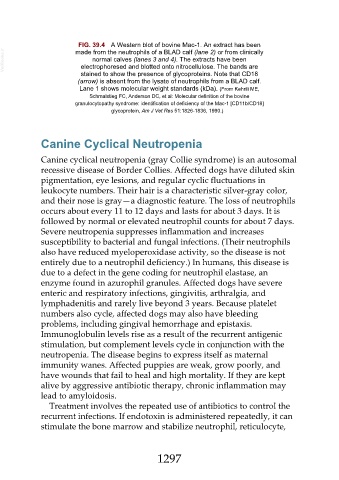Page 1297 - Veterinary Immunology, 10th Edition
P. 1297
FIG. 39.4 A Western blot of bovine Mac-1. An extract has been
VetBooks.ir electrophoresed and blotted onto nitrocellulose. The bands are
made from the neutrophils of a BLAD calf (lane 2) or from clinically
normal calves (lanes 3 and 4). The extracts have been
stained to show the presence of glycoproteins. Note that CD18
(arrow) is absent from the lysate of neutrophils from a BLAD calf.
Lane 1 shows molecular weight standards (kDa). (From Kehrili ME,
Schmalstieg FC, Anderson DC, et al: Molecular definition of the bovine
granulocytopathy syndrome: identification of deficiency of the Mac-1 [CD11b/CD18]
glycoprotein, Am J Vet Res 51:1826-1836, 1990.)
Canine Cyclical Neutropenia
Canine cyclical neutropenia (gray Collie syndrome) is an autosomal
recessive disease of Border Collies. Affected dogs have diluted skin
pigmentation, eye lesions, and regular cyclic fluctuations in
leukocyte numbers. Their hair is a characteristic silver-gray color,
and their nose is gray—a diagnostic feature. The loss of neutrophils
occurs about every 11 to 12 days and lasts for about 3 days. It is
followed by normal or elevated neutrophil counts for about 7 days.
Severe neutropenia suppresses inflammation and increases
susceptibility to bacterial and fungal infections. (Their neutrophils
also have reduced myeloperoxidase activity, so the disease is not
entirely due to a neutrophil deficiency.) In humans, this disease is
due to a defect in the gene coding for neutrophil elastase, an
enzyme found in azurophil granules. Affected dogs have severe
enteric and respiratory infections, gingivitis, arthralgia, and
lymphadenitis and rarely live beyond 3 years. Because platelet
numbers also cycle, affected dogs may also have bleeding
problems, including gingival hemorrhage and epistaxis.
Immunoglobulin levels rise as a result of the recurrent antigenic
stimulation, but complement levels cycle in conjunction with the
neutropenia. The disease begins to express itself as maternal
immunity wanes. Affected puppies are weak, grow poorly, and
have wounds that fail to heal and high mortality. If they are kept
alive by aggressive antibiotic therapy, chronic inflammation may
lead to amyloidosis.
Treatment involves the repeated use of antibiotics to control the
recurrent infections. If endotoxin is administered repeatedly, it can
stimulate the bone marrow and stabilize neutrophil, reticulocyte,
1297

